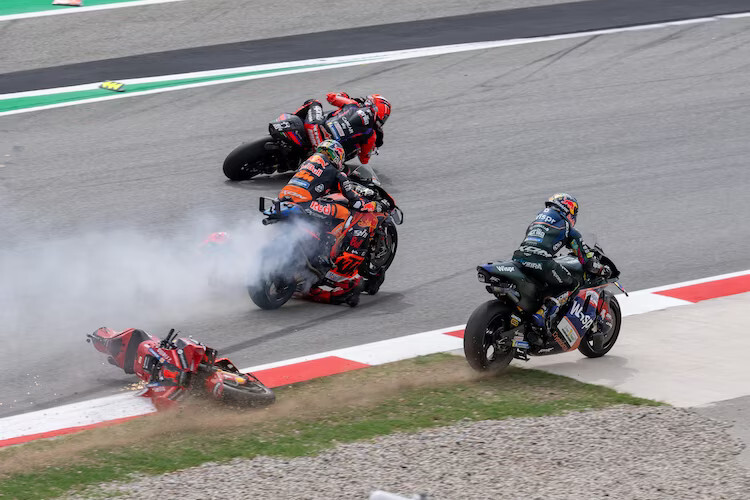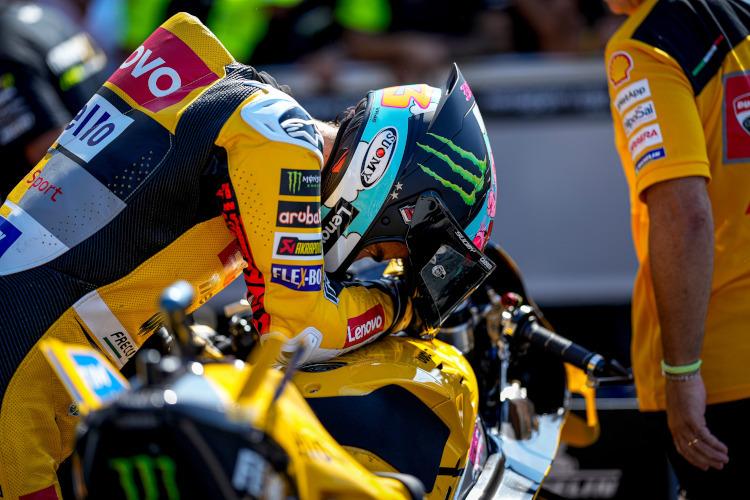Horror-Unfälle und Blitz-Comebacks: Peccos Vorgänger
Meisterschaften werden oft von Stürzen beeinflusst – und das meist negativ. Umso erfreulicher war der glimpfliche Ausgang des Horror-Unfalls kurz nach dem Start des Catalunya-GP: Pecco Bagnaia ging in Führung liegend durch die ersten zwei Kurven, flog dann jedoch wild ab und landete mitten auf der Fahrbahn. Beteiligten und Fans stockte der Atem.
Pecco hatte unglaubliches Glück, den fürchterlichen Highsider ohne Knochenbrüche zu überstehen (laut Ausrüster Alpinestars wirkten beim Aufprall 24 g), und allen Grund dankbar zu sein, dass Brad Binders KTM «nur» seine Beine überrollte. Man mag sich gar nicht ausmalen, was sonst hätte passieren können.
Dennoch: Multiple Prellungen, besonders schmerzhaft am Steißbein, und ein großes Hämatom am rechten Knie sind keine banalen Verletzungen.
Nur vier Tage, nachdem der Ducati-Werksfahrer im Krankenwagen abtransportiert worden war, kehrte er in Misano am vergangenen Donnerstag ins Fahrerlager zurück. Sichtlich angeschlagen und humpelnd, aber immerhin ohne Krücken. Nach der ärztlichen Freigabe stieg er am Freitag wieder auf seine Desmosedici GP23 – wenn auch gemächlich.
Bagnaia setzte die Tradition mutiger Fahrer fort, die Schmerzen und Verletzungen trotzen.
Obwohl der Weltmeister vor der Lenovo-Box regelmäßig das Rear-Ride-Height-Device absenken musste, um überhaupt wieder von seinem Bike klettern zu können, erkämpfte er sich am Freitag den direkten Q2-Einzug. Es folgten ein Platz in der ersten Startreihe und zwei mit eisernem Willen erkämpfte dritte Ränge im Sprint und Hauptrennen.
Mit fünf Siegen aus den ersten zehn Rennen hatte ein gereifter Bagnaia in dieser Saison gerade begonnen, den Eindruck der unbesiegbaren #1 zu erwecken. Ein Titelverteidiger, der sein Schicksal selbst in der Hand hat. Eine gefährliche Position im Motorradsport.
Vor dem Horror-Crash war sein Vorsprung auf Jorge Martin auf 66 Punkte angewachsen – Tendenz steigend. Nach der Beinahe-Katastrophe im Katalonien-GP schrumpfte er auf 50. Trotz Bagnaias heroischem Einsatz knabberte Martin mit einem perfekten Misano-Wochenende weiter am Polster des Italieners. Vor der intensiven Asien-Tournee trennen die beiden Rivalen 36 Zähler. Ein überschaubarer Vorteil, wenn man bedenkt, dass seit diesem Jahr an einem einzigen GP-Wochenende bis zu 37 Punkte zu holen sind.
Schmerzhafte Wendungen im Titelkampf
Besonders zwei Episoden aus den vergangenen drei Jahrzehnten blieben Fans und Beobachtern in bleibender Erinnerung. Sie entschieden nicht nur das Titelrennen, sondern bedeuten auch das Ende von bemerkenswerten Karrieren.
Einmal 1993, als Wayne Rainey einem verletzten Kevin Schwantz rasch näher kam. Es sah danach aus, als sei Rainey auf dem besten Weg zum vierten Titel in Folge – bis zum folgenschweren Unfall in Misano 1993.
1999 war es dann Mick Doohans Crash, der den Weg freimachte für den Titelgewinn seines Repsol-Honda-Teamkollegen Alex Crivillé. Zugegeben, Doohan führte zu diesem frühen Zeitpunkt der Saison die WM-Tabelle nicht an. Kenny Roberts junior, der im Jahr danach triumphieren sollte, hatte bei den Übersee-GP zu Saisonbeginn überraschende Siege gefeiert. Aber kaum jemand zweifelte daran, dass Mick auch das sechste Jahr in Folge dominiert hätte.
Das Pendel kann in beide Richtungen ausschlagen. Doohan war 1992 auf dem besten Weg zum Titel, als er in Assen stürzte. Damals hatte Rainey, zu diesem Zeitpunkt verletzt und Dritter der Gesamtwertung, so gut wie aufgegeben. Mit neu geschöpfter Hoffnung konnte er sein großes Punktedefizit aber noch wettmachen.
Auf der anderen Seite steht die Geschichte einer Rennlegende: Doohans zweifach gebrochenes Bein zog schwere Komplikationen nach sich. Es konnte nur gerettet werden, indem beide Beine zusammengenäht wurden, um die Blutversorgung zu garantieren. Vollkommen gesund wurde es nie mehr, aber Mick kam nach acht Wochen zurück und unternahm in Interlagos bei São Paulo in Brasilien einen verzweifelten Versuch, den Titel zu retten. Am Ende fehlten ihm vier Punkte. Wäre es zum drohenden Fahrerstreik beim vorletzten Grand Prix in Brasilien gekommen, hätte er tatsächlich gewonnen.
Es gibt noch weitere Geschichten, die Bagnaia inspiriert haben könnten. Den Rekord für das schnellste Comeback nach einem doppelten Beinbruch hält Randy de Puniet, der 2010 nach 26 Tagen zurückkehrte. Damit unterbot er Rossis 41 Tage im selben Jahr. Der Unterschied ist, dass Valentino Rossi – auf Krücken – in jenem Deutschland-GP auf Rang 4 landete und eine Woche später in Laguna Seca auf dem Podium stand. Der Titel aber ging an Jorge Lorenzo.
2013 fuhr Jorge Lorenzo in Assen 36 Stunden nach einer Schlüsselbein-OP auf Rang 5 – aber Marc Márquez entschied die WM mit 14 Punkten Vorsprung für sich. 2011 war Colin Edwards in einem nassen Silverstone-GP neun Tage nach einem Schlüsselbeinbruch Dritter. Er wäre schon zuvor gerne den Catalunya-GP gefahren, hatte aber keine Freigabe erhalten.
Barry Sheene war der Comeback-King: 1975 saß er 49 Tage, nachdem er bei einem 250-km/h-Abflug in Daytona unter anderem einen Oberschenkel- und Armbruch erlitten hatte, in Salzburg wieder auf seiner 500-ccm-Zweitakt-GP-Maschine – und damalös gab es noch Schiebestarts! Nach einem heftigen Silverstone-Crash 1992 war er ebenfalls bald wieder zurück.
Es gibt noch mehr solche Helden, die sich nach Verletzungen zurückkämpften: Franco Uncini, Kevin Schwantz und Marc Márquez, um nur drei zu nennen. GP-Piloten haben einfach eine andere Herangehensweise an Verletzungen. Sie ignorieren sie.
Einige von den oben Genannten gewannen nach ihren viel beachteten Comeback-Geschichten noch Weltmeisterschaften. Keiner jedoch im selben Jahr. Vielleicht gelingt es Bagnaia.











